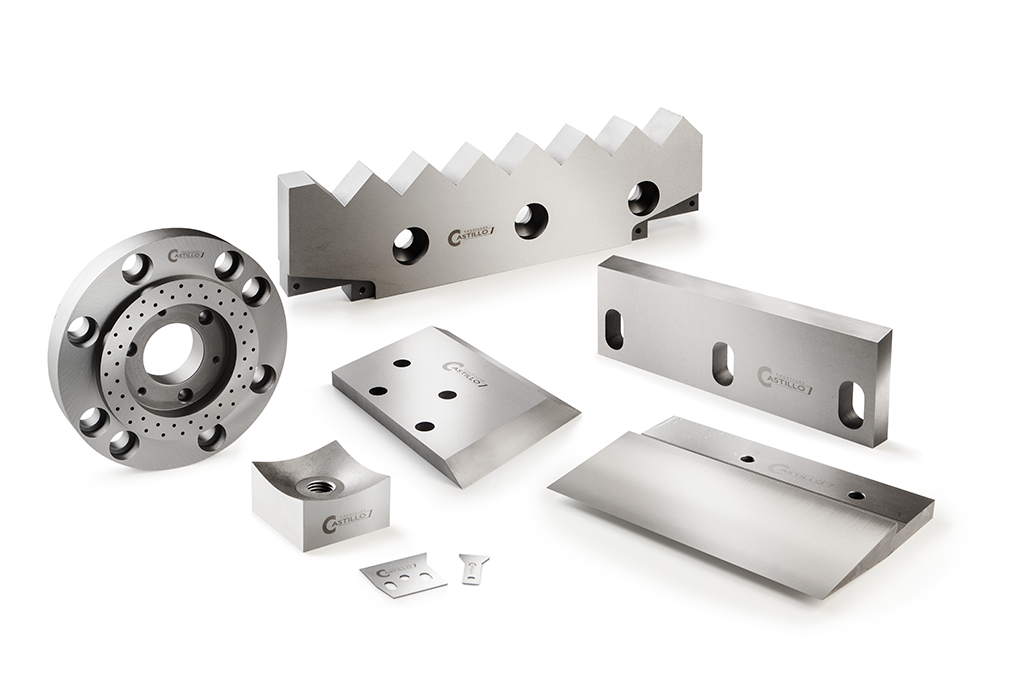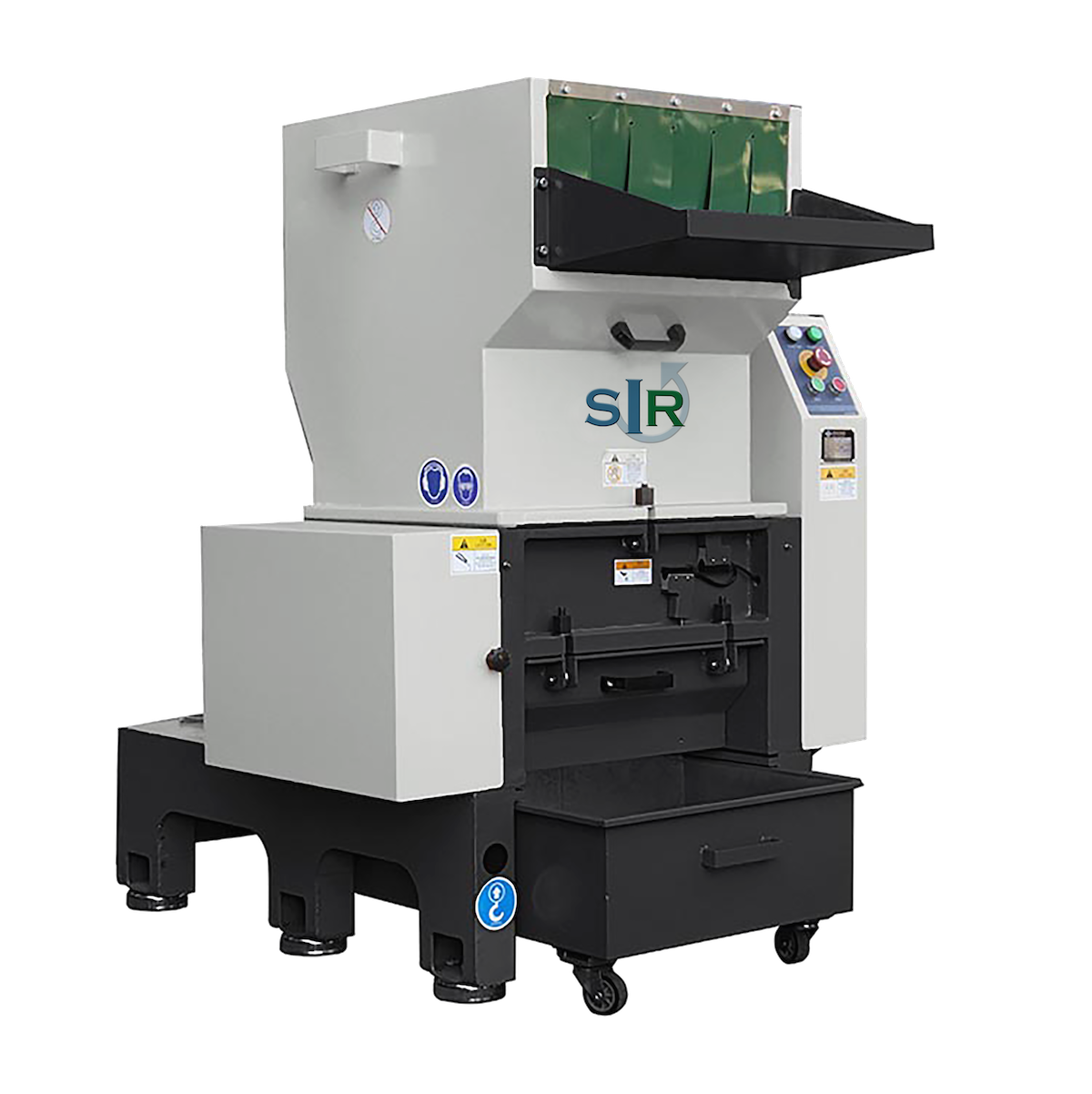Plastic shredding mills are essential in the recycling process and the reduction of plastic waste, transforming it into reusable materials. In this process, the blades play a crucial role, as they are responsible for cutting and shredding plastics into smaller particles, suitable for reuse or final disposal. However, the natural wear of the blades can significantly affect the efficiency and quality of the shredding, making it indispensable to know when and how to replace them, as well as understanding the importance of proper maintenance. This article covers the selection and replacement of blades in plastic shredding mills, providing a guide to optimize their performance and extend their lifespan
The operating principle of a plastic shredding mill is based on the application of mechanical force to reduce the size of the plastic through cutting and grinding. The general process is as follows:
Feeding: The plastic material is introduced through the feed hopper of the mill, which can include old plastics or waste generated during the production process.
Cutting and Grinding: Inside the mill, the plastic passes through the rotor with rotating blades and the stator, which work together to cut and grind the material into smaller particles. The cutting occurs repeatedly as the rotor spins at high speed.
Size Reduction: Simultaneously, the particles are refined to reach the desired granularity through the friction and pressure generated by the movement of the blades.
Screening and Separation: The mill is equipped with screens or filters that allow only particles of the appropriate size to pass through, while larger ones remain in the system for further processing.
Output: The shredded material exits the mill in the form of uniform particles ready to be recycled or processed in subsequent steps.
This process ensures that the plastic is effectively reduced to the necessary size for reuse or recycling, optimizing the quality and efficiency of plastic material handling.
Main Components of Plastic Shredding Mills
Plastic shredding mills consist of several key components that ensure their efficient operation:
- Feed Hopper: Where the plastic material is introduced for shredding.
- Rotor: A shaft with rotating blades that performs the cutting of the plastic.
- Blades: Cutting elements mounted on the rotor and stator, essential for shredding the material into smaller particles.
- Stator: The fixed part of the mill that works in conjunction with the rotor to cut the plastic.
- Motor: Provides the necessary power for the rotation of the rotor and the movement of the blades.
- Screens or Filters: Determine the final size of the shredded particles, ensuring uniformity in the final product.
These components work in synchrony to ensure an efficient shredding process tailored to the specific needs of plastic recycling.
Standard Shredding Mills SRB-5 Series by Soluciones Industriales para el Reciclado (SIR)
Vulnerable Parts and Maintenance Methods
Vulnerable Parts of Plastic Shredding Mills:
- Blades or Cutting Tools: These are critical for the operation of the mill, as they perform the cutting and grinding of the plastic. Due to frequent contact with hard materials or large volumes of plastic, these blades are prone to wear and can lose their sharpness quickly. It is essential to sharpen or replace them regularly to maintain the mill’s efficiency.
- Screens or Filters: These components control the size of the shredded plastic particles. Screens can wear out or become clogged due to the accumulation of plastic residues, which can affect the uniformity of particle size and reduce process efficiency. They need regular cleaning or replacement.
- Bearings: Rotating components, such as the rotor, depend on bearings to function correctly. These bearings are subject to wear due to constant high-speed rotation and friction. To avoid failures in the mill, it is crucial to conduct periodic inspections, provide adequate lubrication, and replace bearings when necessary.
- Belts or Chains: Used in the mill’s transmission system, these parts are essential for transferring power from the motor to the rotor. Belts or chains can be damaged by prolonged operation, uneven tension, or aging, and require frequent inspections and timely replacements to maintain the normal operation of the system.
- Seals: Seals prevent the entry of plastic fragments and other impurities into the mill and prevent lubricant leaks. Over time, these seals can fail due to wear or aging, so it is important to inspect and replace them regularly.
- Motor: If the shredding mill operates electrically, the motor is an essential and also vulnerable component. Motors can be damaged due to prolonged operation, overloads, or other factors. Regular inspections and proper maintenance are necessary to ensure the motor functions correctly and to replace it if failures occur.
Common Maintenance Methods:
Proper maintenance of the vulnerable and consumable parts of plastic shredding mills can extend the machine’s lifespan and ensure efficient operation. Here are some common maintenance methods:
- Periodic Cleaning and Lubrication: Regularly clean the internal and external surfaces of the mill to remove plastic build-up and other impurities. Lubricate bearings, chains, transmission belts, and other moving components to reduce wear and ensure smooth operation.
- Regular Inspection and Adjustment: Regularly check the wear status and working conditions of blades, screens, bearings, seals, and other components. Make necessary adjustments, such as the clearance of the blades or the tension of the belts, to ensure the mill operates optimally and efficiently.
- Use of Suitable Plastic Materials: Carefully select appropriate plastic materials for shredding to avoid introducing hard or difficult-to-handle materials into the machine, which reduces wear on blades and other components.
- Avoid Overloading: Operating the mill within its design capacity is crucial to avoid accelerated wear and damage to components. Overloading can significantly increase the risk of failures and reduce the machine’s lifespan.
- Regular Replacement of Consumable Parts: Replace consumable parts, such as blades, screens, and bearings, following the manufacturer’s recommendations and based on observed use and wear. This ensures the mill operates efficiently and without interruptions.
- Periodic Inspection of Motors and Electrical Systems: For electrically operated mills, regularly inspect the motor and electrical system, ensuring proper connections and the good condition of the motor, and address any detected issues promptly.
How to Determine When to Replace Blades
To determine when to replace the blades of plastic shredding mills, it is essential to observe several indicators of wear and loss of effectiveness.
A decrease in the mill’s efficiency, such as an increase in the time required to process the same volume of plastic, can be a clear sign of worn blades. Blades that have lost their sharpness do not cut or shred the plastic effectively, affecting the overall performance of the machine.
Reduced output quality is another key sign; dull blades can result in uneven particle sizes, excessive granulation, or large pieces of uncut plastic. These output quality issues suggest that the blades need to be replaced.
It is crucial to conduct regular visual inspections of the blades to assess their condition. Highly worn blades will show visible signs of material loss, worn edges, or deformations. If significant damage is detected, it is time to consider replacing them.
Additionally, unusual noises or vibrations during the mill’s operation can indicate severe blade wear. An increase in noise levels or vibrations compared to normal operation may signal that the blades are compromised and should be replaced to maintain the safety and efficiency of the equipment.
Types of Blades for Recycling and Their Selection

There are several types of blades used in plastic shredding mills, and their selection depends on the type of material to be processed and the desired outcome.
- Straight Blades: These blades are common in mills that process hard plastics. They offer precise cuts and are suitable for shredding materials such as PET bottles and HDPE containers.
- Serrated Blades: Designed with a serrated edge, these blades improve grip and cutting capability on softer or fibrous plastics, like films and sheets. They are useful for shredding materials that tend to slip or are difficult to capture with smooth blades.
- Spiral Blades: These blades allow for continuous and smooth cutting, which reduces vibration and equipment wear. They are effective in maintaining a smooth shredding process and are used in applications where uniform and continuous cutting is required.
- Shear Blades: Used in double-shaft shredders, these blades interlock to cut and tear through thicker and more rigid plastic materials, such as PVC pipes and automotive parts. They offer greater control over the size of the shredded material.
- Granulator Blades: Similar to mills and chippers, these blades are designed to reduce plastics into fine pieces. They are especially useful in recycling processes where the goal is to convert material into uniform granules.
Selecting the correct blades is crucial for maximizing the efficiency of the shredding process and ensuring the longevity of the equipment. In addition to considering the type of plastic to be processed, it is important to account for the hardness and wear resistance of the blades, making it preferable to opt for high-quality materials such as high-chrome tempered steel.
Blade Replacement Process for Plastic Shredding Mills
Replacing blades in plastic shredding mills is a critical process to maintain the efficiency and safety of the equipment. Below are the general steps for proper blade replacement:
Preparation and Safety: Before starting, it is essential to stop the mill and disconnect it from the power source to avoid accidents. Use personal protective equipment, such as cut-resistant gloves and safety glasses.
Access to the Blades: Remove the protective covers or panels of the mill to access the blades. This may involve loosening screws or bolts that secure the covers in place.
Removal of Worn Blades: Using the appropriate tools, unscrew the worn blades from the rotor and stator. Handle the blades carefully, as they may have sharp or dull edges that could be dangerous.
Inspection and Cleaning: Once removed, inspect the mounting areas for any damage or debris that could interfere with the installation of new blades. Clean the surfaces and ensure all components are in good condition.
Installation of New Blades: Place the new blades in the blade holder, ensuring they are correctly aligned. Use the proper tools to secure the new blades to the blade holder, tightening bolts or other fasteners to ensure that the blades are correctly adjusted to avoid vibrations or irregular cuts.
Final Adjustment and Verification: After installing the new blades, adjust any necessary components, such as the spacing between blades or belt tension, according to the manufacturer’s specifications. Perform a final check to ensure everything is secure and ready to operate.
Operational Test: Reconnect the power source and turn on the mill for a test run. Observe the initial operation for any abnormal vibrations or noises that could indicate an issue with the installation.
At Cuchillas Castillo, we not only specialize in the manufacturing, repair, and sale of plastic shredding mills, but we also offer comprehensive maintenance services. Our team has the knowledge and tools necessary to perform the work correctly, minimizing the risk of errors that could compromise the equipment’s operation or the safety of the operators. With our services, we ensure that the mills operate at their maximum capacity and efficiency, providing comprehensive solutions for all plastic handling and processing needs.


